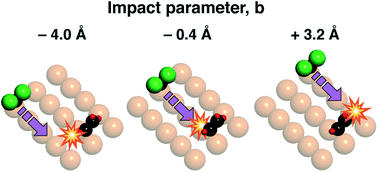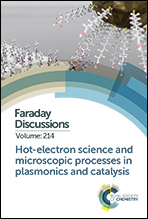Electron-induced molecular dissociation at a surface leads to reactive collisions at selected impact parameters
Abstract
Crossed molecular beams of gases have provided definitive information concerning the dynamics of chemical reactions. The results have, however, of necessity been averaged over collisions with impact parameters ranging from zero to infinity, thus obscuring the effect of this important variable. Here we employ a method through which impact parameter averaging is suppressed in a surface reaction. We aim a highly collimated reactive ‘projectile’ molecule along a surface at a stationary adsorbed ‘target’ molecule, with both the projectile and target being observed by Scanning Tunnelling Microscopy (STM). The projectile was CF2 recoiling from electron-induced bond-breaking in chemisorbed CF3 on Cu(110) at 4.6 K. The collimation of the resulting CF2 ‘surface-molecular-beam’ restricted it to a lateral spread of ±1° as a consequence of its interaction with the Cu rows below. This collimation was modelled by molecular dynamics simulations. In the experiments the recoiling CF2 projectile was aimed, successively, at impact parameters of b = 0 and +3.6 Å at a chemisorbed second CF2, b = +1.8 Å at a chemisorbed I-atom, or b = −4.0, b = −0.4 and b = +3.2 Å at a chemisorbed vinyl radical. The pattern of reactive and non-reactive scattering was determined by STM. These collimated surface-molecular-beams have the potential to aim molecular projectiles with selected impact parameters at the many target species identifiable at a surface by STM.

- This article is part of the themed collection: Hot-electron science and microscopic processes in plasmonics and catalysis


 Please wait while we load your content...
Please wait while we load your content...